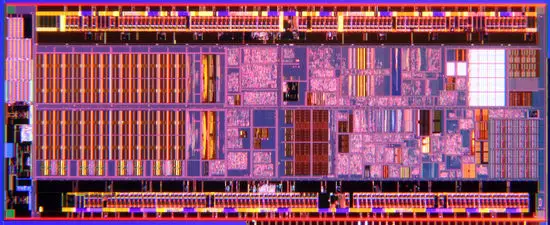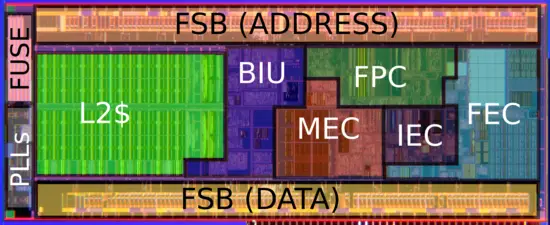| Line 18: | Line 18: | ||
| inst = Yes | | inst = Yes | ||
| − | | feature = MMX | + | | feature = |
| − | | extension | + | | extension = MMX |
| − | | extension | + | | extension 2 = SSE |
| − | | extension | + | | extension 3 = SSE2 |
| − | | extension | + | | extension 4 = SSE3 |
| + | | extension 5 = SSSE3 | ||
| cache = Yes | | cache = Yes | ||
Revision as of 20:42, 9 April 2016
| Edit Values | |
| Bonnell µarch | |
| General Info |
Bonnell was a microarchitecture for Intel's 45 nm ultra-low power microprocessors first introduced in 2008 for their then-new Atom family. Bonnell, which was named after the highest point in Austin - Mount Bonnell, was Intel's first x86-compatible microarchitecture designed to target the ultra-low power market.
Contents
[hide]Codenames
| Chipset | Platform | PHC | Core | Target |
|---|---|---|---|---|
| Poulsbo | Menlow | Silverthorne | MIDs | |
| Poulsbo | Menlow | Diamondville | Nettops | |
| Moorestown | Langwell | Lincroft | MIDs | |
| Pine Trail | Tiger Point | Pineview | Nettops | |
| Queens Bay | Topcliff | Tunnel Creek | Embedded | |
| Queens Bay | Topcliff | Stellarton | Embedded + Altera FPGA | |
| Sodaville | CE | |||
| Groveland | CE |
Generation successor
| First Generation | Second Generation | |
|---|---|---|
| Silverthorne | → | Lincroft |
| Diamondville | → | Pineview |
| Tunnel Creek | ||
| Stellarton | ||
| Sodaville | ||
| Groveland |
Architecture
Bonnell's primary goals were:
- Reduce power consumption,
- while staying fully x86-compatible,
- at acceptable performance
Performance/Power new rule: +1% performance for at most +1% power consumption.
Memory Hierarchy
- Cache
- Hardware prefetchers
- L1 Cache:
- 32 KB 8-way set associative instruction
- 1 read and 1 write port
- 24 KB 6-way set associative data
- 1 read and 1 write port
- 8 transistors (instead of 6) to reduce voltage
- Per core
- 32 KB 8-way set associative instruction
- L2 Cache:
- 512 KB 8-way set associative
- ECC
- Shrinkable from 512 KB to 128 KB (2-way)
- Per core
- L3 Cache:
- No level 3 cache
- RAM
- Maximum of 2 GB, 4 GB, and 8 GB
Note that the L1 cache for data and instructions were originally both 32 KB (8-way), however due to power restrictions, the L1d$ was later reduced to 24 KB.
Functional Units
The number of functional units were kept to minimum to cut on power consumption.
- 2 Integer ALUs (1 for jumps, 1 for shifts)
- 2 FP ALUs (1 adder, 1 for others)
- No Integer multiplier & divider
Pipeline
Much like other x86 microarchitectures, Bonnell converts the complex instructions into finer micro-ops when needed. However, most instructions in Bonnell do not break down into simpler micro-ops (since Bonnell is not OoOE, there is no real advantage in doing so anyway). Most instructions actually correspond very closely to the original x86 instructions. Intel estimates that only 5% of common software require instructions to be split up. Bonnell has a 16-stage pipeline with a 13-stage miss penalty. Bonnell is a dual-issue superscalar but with in-order execution (in fact, first microarchitecture since Pentium Pro to not feature a OoOE). The elimination of reordering logic allowed for lower power consumption and small die area. This does imply the overall MPU is less efficient in managing its own resources; memory accesses and FP operations also stall the whole pipeline. Bonnell employed Safe Instruction Recognition (SIR) and Simultaneous multithreading (SMT) to bring performance to acceptable level. Intel claimed sub-20% power consumption penalty while improving performance between 30% and 50%.
The longer pipeline allows a more evenly spreading of heat across the chip with more units. This also allows a higher clock rate.
- Instruction Fetch
- 3 stages
- 8 Bytes/Cycle (lower if SMT)
- Instruction Decode
- 3 stages
- Instructions with up to 3 prefixes/Cycle
- Instruction Dispatch
- 2 stages
- Source Operand Read
- 1 stage
- reading register operand
- 1 stage
- Data Cache Access
- 3 stages
- 1 stage for calculating
- 2 stages for reading cache
- 3 stages
- Execution
- 2 clusters
- integers
- quick cache access due to direct connection
- floating point & SIMD
- integers
- 2 clusters
- Exception & MT Handling
- 2 stages
- Commit
- 1 stage
Multithreading
Bonnell has support for multithreading - up to two threads per core. However each thread compete for the same resources which does inherently means they run slower than they would if they were to run alone.
Branch Prediction
- Two-level adaptive predictor
- 12-bit branch history register
- Pattern history table has 4096 entries (shared between threads)
- Branch buffer target has 128 entries (4-way, 32 sets)
- Unconditional jumps are ignored
- Always-taken and never-taken are marked in the table
- Penalties:
- 13 stages for miss prediction
- 7 stages for correct prediction but missing branch target buffer (BTB)
Die
 |
|

|
- The die is 3.1mm x 7.8mm (24.2mm2)
Cores
First Generation
First generation of Bonnell-based microprocessors introduced 2 cores: Silverthorne for ultra-mobile PCs and mobile Internet devices (MIDs) and Diamondville for ultra cheap notebooks and desktops.
Silverthorne
- Main article: Silverthorne
Silverthorne was the codename for a series of Mobile Internet Devices (MIDs) introduced in 2008. These processors had 1 core and 2 threads with a FSB operating at 400 MHz-533 MHz.
Diamondville
- Main article: Diamondville
Diamondville was the codename for the series of ultra cheap notebooks and desktops introduced in 2008. Diamondville is very much a soldered-on-motherboard derivative of Silverthorne with faster FSB (operating at 533 MHz - 667 MHz). The dual-core version is an MCM (Multi Chip Module) Silverthorne variant.
Second Generation
First generation of Bonnell-based microprocessors while being low power had to work with the older 90 nm process 945GSE chipset and 82801GBM I/O controller with a TDP of almost 9.5 watts - almost 4 times that of the processor itself. Second generation Bonnell-based microprocessors aimed to address this issue by integrating a memory controller and GPU on-chip. This drastically reduced power consumption and cost.
Lincroft
- Main article: Lincroft
Lincroft is the codename for Bonnell-based Silverthorne's successor. Lincroft integrates on-die the graphics and memory controller.
Pineview
- Main article: Pineview
Pineview was the codename for second generate Bonnell-based processors which integrated a memory controller, Direct Media Interface (DMI) link, and the GMA 3150 GPU. Pineview is the successor for Diamondville, targeting the same ultra cheap desktops, nettops and netbooks.
Tunnel Creek
- Main article: Tunnel Creek
Tunnel Creek was the codename for a series of MPUs for embedded applications.
Stellarton
- Main article: Stellarton
Stellarton was the codename for a series of MPUs for embedded applications. Stellarton is the Tunnel Creek core packaged with an Altera FPGA.
Sodaville
- Main article: Sodaville
Sodaville is the codename for a series of consumer electronics system on a chip (e.g. set-top box).
Groveland
- Main article: Sodaville
Sodaville is the codename for a series of consumer electronics MPUs (e.g. smart TVs).
